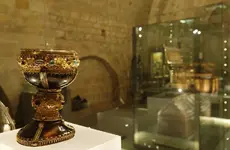lokiblossom
Bronze Member
- Joined
- Dec 4, 2014
- Messages
- 1,865
- Reaction score
- 1,310
- Golden Thread
- 0
- Location
- Traverse City, Mi.
- Primary Interest:
- Relic Hunting
- #21
Thread Owner
A quote I found while researching some of your keywords Loki: "Since Peter-Roger of Mirepoix had been given permission to take all gold and silver with him, what the four intrepid Cathars brought to safety in the caves of the Sabarthes on the lands of the Lords of Castellum Verdurum certainly wasn’t that."
No, it wasn't. When I mention the 160,000 florins of gold the Templar's may have brought to Nova Scotia, it was their own treasure that they had brought from Cyprus. There may have also been some treasures from their Paris headquarters, Temple Villeneuve.
What the Cathar's had saved from the inquisition and later passed on to the Templar's was much more important. It was the same object Otto Rahn mistakenly thought was still within the mountain pog of Montsegur, The Holy Grail.
Cheers, Loki
Amazon Forum Fav 👍
Last edited:




